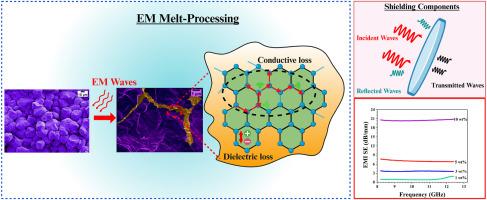Morphology-driven electromagnetic shielding performance of graphitic nanoparticles in segregated polypropylene nanocomposites via electromagnetic melt processing
IF 7.7
2区 材料科学
Q1 MATERIALS SCIENCE, COMPOSITES
引用次数: 0
Abstract
Electromagnetic (EM) melt-processing has emerged as an innovative and energy-efficient strategy for the structuring of thermoplastic nanocomposites (TPNCs). In this study, polypropylene (PP)-based TPNCs were fabricated using different grades of graphitic carbon nanoparticles (CNPs) to yield electrical conductivity and electromagnetic interference shielding effectiveness (EMI SE). The applied structuring methodology consists of a multiscale processing strategy that combines high-energy ball milling of polymer micro-pellets and CNPs, formulated powder compaction into green bodies, and EM-driven localized heating to produce the TPNCs. This enables the formation of highly segregated, percolated conductive networks at ultra-low filler loadings. The percolation threshold values for green bodies were significantly dependent on CNP morphology, ranging from approximately 0.50 wt% for low-aspect-ratio graphene nanoplatelets to around 1.0 wt% for medium-aspect-ratio carbon nanotubes (CNTs). Upon EM melt-processing, due to viscoelastic deformation of CNP networks, the resulting threshold values of the structured TPNCs were approximately 0.73 wt%, 0.50 wt%, and 0.74 wt% for low, medium, and high aspect ratios, respectively. High-aspect-ratio CNTs, despite exhibiting greater structural defects, achieved the highest EMI SE of 19.7 dB/mm at 10 wt%, demonstrating that morphology dominates over graphitic crystallinity in governing transport properties and electromagnetic performance. Statistical modeling via response surface methodology (R2 = 0.9988) confirmed the predictive significance of the CNP morphology and the concentration responses. This work underscores the critical influence of filler architecture and EM-induced structuring in enabling a novel, scalable platform for multifunctional polymer nanocomposites with enhanced electromagnetic shielding capabilities, offering promise for next-generation aerospace, electronics, automotive, and defense applications.

电磁熔体工艺制备分离聚丙烯纳米复合材料中石墨纳米粒子的电磁屏蔽性能
电磁熔融加工已成为热塑性纳米复合材料(tpnc)结构的一种创新和节能策略。在本研究中,使用不同等级的石墨碳纳米颗粒(CNPs)制备聚丙烯(PP)基tpnc,以提高其导电性和电磁干扰屏蔽效果(EMI SE)。应用的结构方法包括一种多尺度加工策略,该策略结合了聚合物微球和CNPs的高能球磨,配方粉末压实成绿色体,以及em驱动的局部加热来生产tpnc。这使得在超低填料负载下形成高度分离、渗透的导电网络。绿体的渗透阈值显著依赖于CNP形态,范围从低纵横比石墨烯纳米片的约0.50 wt%到中等纵横比碳纳米管(CNTs)的约1.0 wt%。在EM熔融处理过程中,由于CNP网络的粘弹性变形,在低、中、高长宽比下,结构化tpnc的阈值分别约为0.73 wt%、0.50 wt%和0.74 wt%。尽管高纵横比碳纳米管表现出更大的结构缺陷,但在10 wt%时,其EMI SE达到了19.7 dB/mm的最高水平,这表明形貌在控制传输性能和电磁性能方面优于石墨结晶度。通过响应面法建立的统计模型(R2 = 0.9988)证实了CNP形态和浓度响应的预测意义。这项工作强调了填料结构和电磁诱导结构在实现具有增强电磁屏蔽能力的多功能聚合物纳米复合材料的新型可扩展平台方面的关键影响,为下一代航空航天,电子,汽车和国防应用提供了希望。
本文章由计算机程序翻译,如有差异,请以英文原文为准。
求助全文
约1分钟内获得全文
求助全文
来源期刊

Composites Communications
Materials Science-Ceramics and Composites
CiteScore
12.10
自引率
10.00%
发文量
340
审稿时长
36 days
期刊介绍:
Composites Communications (Compos. Commun.) is a peer-reviewed journal publishing short communications and letters on the latest advances in composites science and technology. With a rapid review and publication process, its goal is to disseminate new knowledge promptly within the composites community. The journal welcomes manuscripts presenting creative concepts and new findings in design, state-of-the-art approaches in processing, synthesis, characterization, and mechanics modeling. In addition to traditional fiber-/particulate-reinforced engineering composites, it encourages submissions on composites with exceptional physical, mechanical, and fracture properties, as well as those with unique functions and significant application potential. This includes biomimetic and bio-inspired composites for biomedical applications, functional nano-composites for thermal management and energy applications, and composites designed for extreme service environments.
 求助内容:
求助内容: 应助结果提醒方式:
应助结果提醒方式:


